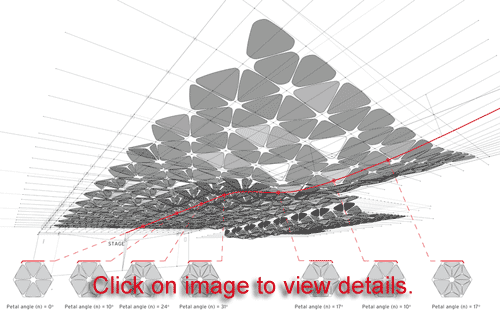When the Whole Is Greater Than the Sum of Its Parts
Learning Objectives:
- Explain why computer numerical controlled (CNC) milling is used to create building components.
- Identify various computer programs that are used to create the 3D models and fabrication drawings for CNC machines.
- Understand how the architects and consultant coordinate various aspects of the design using analysis software.
- Describe the fabrication and installation process for CNC-milled parts.
Credits:
Computer numerical control (CNC) milling machines have been around for decades. Originally developed for the aerospace industry to facilitate the precise machining of complex shapes, CNC mills have since become the go-to gadget for everyone, from product designers to architects who want their intricate designs fabricated fast. The off-site machining of building elements expedites their installation, drastically reducing construction time.
Hagy Belzberg, AIA, principal of Santa Monica�based Belzberg Architects, has incorporated CNC milling in several memorable projects. For the Patina Restaurant at the Walt Disney Concert Hall in Los Angeles [RECORD, December 2003, page 100], a CNC-milling machine carved 800-pound blocks of laminated walnut two-by-fours into lushly curving wall elements, some up to 8 feet tall, to evoke the look of stage curtains being drawn. For the Conga Room dance club, also located in L.A., Belzberg used CNC milling to create an altogether different effect. Rather than very large, heavy elements, Belzberg assembled nearly a thousand small, lightweight panels to create undulating surfaces over the club's dance floor and lobby. "At Patina, the CNC milling machine had to do quite a bit of work," Belzberg recalls. "For the Conga Room, the digital design process became the most labor-intensive aspect of the project."
The Conga Room already had a reputation as a premiere Latin dance club. Its new location within the downtown entertainment campus known as L.A. Live provided more space for clubgoers to shimmy and salsa. But its position on the second floor of a building that contains mainly offices posed several challenges for the architects. One difficulty became creating a space that would draw visitors from the first-floor restaurants and shops to the upper level. More important, the architects needed to ensure that the loud music did not disturb neighbors inside the multiuse building.
 |
In the Conga Room's dance hall, a variety of petal shapes hung at various angles form the undulant ceiling. |









